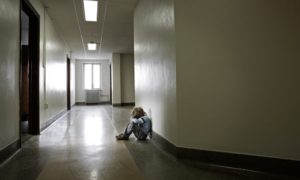 In a previous column, I wrote about the federal law requiring states to make “reasonable efforts” to keep families together in order to spare children from the chaos and disruption of foster care. In theory, when a child welfare agency fails to do that the case is not eligible for federal foster care assistance. I wrote about how enforcement of this law is such a joke that in one state, Alaska, the head of the child welfare agency could treat this mandate with contempt.
In a previous column, I wrote about the federal law requiring states to make “reasonable efforts” to keep families together in order to spare children from the chaos and disruption of foster care. In theory, when a child welfare agency fails to do that the case is not eligible for federal foster care assistance. I wrote about how enforcement of this law is such a joke that in one state, Alaska, the head of the child welfare agency could treat this mandate with contempt.
Contempt also is a good way to describe how the Massachusetts Department of Children and Families (DCF) regards this mandate — in spite of the fact that the Massachusetts Legislature has incorporated the “reasonable efforts” requirement into state law.
While not as bad as Alaska, a take-the-child-and-run mentality has long dominated Massachusetts child welfare. Year after year, the state tears apart families at a rate well above the national average, even when rates of child poverty are factored in. In recent years the problem has been compounded by a foster care panic, a sharp increase in children taken from their homes following news coverage of child abuse tragedies.
Mostly, it’s all gone under the radar — except for one time when DCF made the mistake of treating a middle-class foster family the way it normally treats impoverished birth families. And the time when two federal agencies censured Massachusetts for discriminating against disabled parents.
But now, the state’s Supreme Judicial Court has signaled that it’s had enough. A unanimous ruling issued on Oct. 20 offers rare insight into how the child welfare system really works.
Facts of the case
In June 2016, a caseworker for the Massachusetts Department of Children and Families found a couple and their child living with the child’s paternal grandmother in a dirty home. The child’s bedroom floor allegedly “was so covered with boxes, clothing trash and debris that there was no room to walk.”
The parents also smoked marijuana — apparently a particular hot-button issue for DCF, as evidenced by their unsuccessful opposition to making this legal in the state. (It was still illegal when this case arose.) There was no evidence that the child had been beaten or tortured, no indication that he was malnourished or neglected.
The parents said they were not living in these circumstances by choice. It was all they could afford.
This is exactly the sort of typical case in which, two massive studies found, children typically fare better when left in their own homes than they do when placed in foster care. And it is precisely the kind of case for which reasonable efforts are suited.
DCF could have sent in housekeepers. Or DCF could have relocated the family to better housing. But that’s not what happened. According to the court decision, during the second hearing held on the case:
The investigator admitted at the hearing that she did not know whether the department was able to provide families with homemaking or babysitting services, whether the family support services the department provides included “chore services,” or whether counselling and management services were available to prevent the removal of children from their parents by the department. [As the decision mentions in a footnote, such services are, in fact, supposed to be available.]
She also testified that, as an investigator, it was not her job to make reasonable efforts to prevent or eliminate the need for removal before removing a child to the custody of the department. As to [the child], she admitted that she decided to remove [him] within ten minutes of being in the home, before she spoke with the father. She also admitted that, before she placed [him] in the custody of the department, she did not explore with the family possible alternatives to avoid the need for foster care.
A claim that ‘simply was not true …’
That only came out at the second hearing in the case, when all sides are present. At the first court hearing, a so-called emergency hearing with only DCF present, DCF told a different story.
The investigator and her supervisor submitted an affidavit claiming that “reasonable efforts by the department were attempted; however the parents have either not participated or only minimally participated.” Based on that claim, the trial court rubber-stamped the removal and checked a box saying that reasonable efforts had been made.
But, as the Supreme Judicial Court bluntly put it, the claim in that affidavit “simply was not true …”
In spite of the fact that the initial “reasonable efforts” determination was based on a false claim, made at a hearing where the family was not present, DCF went on to argue that judges should not have to go back and recheck at subsequent hearings where both sides are heard.
The Supreme Judicial Court didn’t buy it. Nor did it buy DCF’s most alarming claim of all: that the only harm done by the failure to make reasonable efforts is the possible loss of some federal money.
What about the adverse consequences of needlessly placing a child in foster care? What about the enormous psychic trauma? What about the serious risk of abuse in foster care itself? If Massachusetts DCF doesn’t understand those consequences then the agency itself is the ultimate “unfit parent.”
Fortunately the Supreme Judicial Court does understand. Not only did it rule that judges have to take the reasonable efforts issue more seriously, including rechecking at the second hearing, it also ruled that when DCF fails to make reasonable efforts judges have the power to order specific steps to try to minimize the damage and promote the safe reunification of families.
But one question remains: Will Massachusetts do any better at enforcing “reasonable efforts” than the federal government has done?
Richard Wexler is executive director of the National Coalition for Child Protection Reform.




























